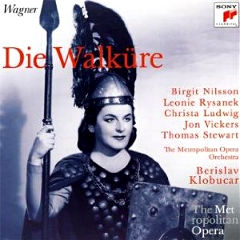
Five decades before the Met turned to computer-assisted planks to help tell the story of Wagner’s Ring cycle, the company stirred controversy and comment with another staging of the tetralogy. General Manager Rudolf Bing imported a stark, abstract production from the Salzburg Festival in order to secure the services of Herbert von Karajan, who not only conducted but hand-picked most of the cast and insisted on supervising everything from lighting to blocking of the principals.
While the maestro’s dramatic instincts may have been suspect (his outspoken Brünnhilde, Birgit Nilsson, famously showed up for a rehearsal wearing a miner’s helmet to mock the dimly lit stage setting), the singing by a starry roster including Jon Vickers, Leonie Rysanek, Christa Ludwig, Karl Ridderbusch and Nilsson was widely hailed as the best Wagner New York had experienced since the Met’s 1930s pairings of Lauritz Melchior and Kirsten Flagstad. Bing, whose aversion to the composer was well-known and who hated yielding power, showed if nothing else he was capable of making enlightened compromises.
Karajan took ill before the first installment of the cycle was broadcast. But the Feb. 28, 1968 performance of Die Walküre heard live on the radio reflects his scrupulous preparation and is one of the more noteworthy specimens in the Met’s archives. It’s part of the second batch of historic Met performances just released by Sony (3 CDs, $19.97).
Anyone who recently experienced the Met’s amped-up new Walküre in movie theaters will be struck by the utterly natural sound of the CD. Though the orchestra seems a bit distant, the absence of enhancements allows a listener to better judge the quality and texture of the voices, especially near the top of the dynamic range. The American bass baritone Thomas Stewart comes across as a very flesh-and-blood Wotan who marshals his smallish voice to wrenching emotional effect in the Act 3 farewell to Brünnhilde and sounds helplessly out of his league in the Act 2 confrontation with Ludwig’s formidable Fricka, when he agrees to sacrifice Siegmund to avoid breaking the laws against incest and adultery.
Nilsson, who couldn’t stand Karajan and was cast at the insistence of Bing, is a force of nature, spot-on throughout the registers and almost overwhelming as she unleashes high B’s and C’s in her Hojotohos. Yet beyond the sheer power is a savvy actress who also captures the impulsive, reckless nature of her character.
Vickers more or less owned the role of Siegmund at the time of these performances and is both unforced and intense, oozing passion and power in the Act 1 Winterstürme after vividly recalling his mishap-filled life to Sieglinde and Hunding. The role of Sieglinde sat low for Rysanek, who wobbles a bit in the middle register. But the veteran soprano matches Vickers’ dramatic impact with breathtaking high notes and an appropriately enraptured scream when Siegmund removes the sword from the tree in the climactic moment of Act 1. Next to these two, Ridderbusch comes off a bit wooden, though his bass is suitably dark and threatening.
Karajan’s replacement in this run of performances was the veteran Croatian conductor Berislav Klobucar, who draws a brisk, sure-paced performance from the Met orchestra. While Karajan brought a transparent, chamber-music like quality to the Ring that once critic said “engag[ed] the listener’s imagination rather than overwhelming the ear,” Klobucar is more in the mold of a Clemens Krauss or Joseph Keilberth: exciting in right places, ever-conscious of the music’s flow and always supportive of the singers. The pre-James Levine Met orchestra, which rehearsed the work with Karajan the previous fall, acquits itself quite well, notwithstanding a few flubs in the brass.
For all its virtues, this performance doesn’t rank above the masterful Karajan Walküre on Deutsche Grammophon or Keilberth’s remarkable live version from the 1955 Bayreuth Festival on Testament
. Still, the Sony Met entry is an important historical document at a bargain price that would be worth buying for Nilsson’s and Vickers’ performances alone.


























Comments